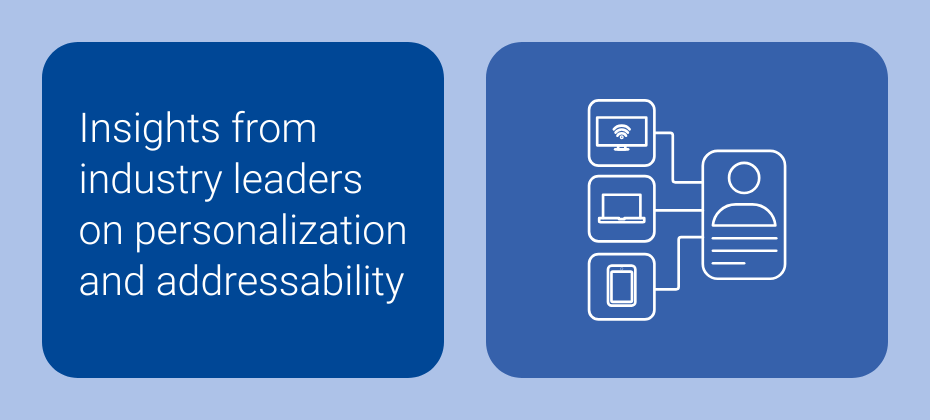
Today, Experian announced a suite of next-generation solutions that will help marketers navigate the challenges of cookie deprecation. Powered by the Experian Graph, these solutions will enable marketers to maintain behavioral targeting at scale.
- In partnership with Audigent, Experian announced the early-stage limited availability of Experian Audiences inside the Privacy Sandbox through the Protected Audiences API.
- Experian has also co-developed, with Audigent, an AI-driven contextual targeting solution layered with Experian’s rich Experian Marketing Data to continue delivering marketers scale and performance from their campaigns.
- Finally, Experian continues to evolve its signal-agnostic Graph, including coverage for industry-leading universal IDs, and plans to support IPv6 and phone-based UID2s.
With these solutions, marketers can confidently deliver behavioral targeting after cookie deprecation and benefit from the power of Experian Marketing Data in their contextually targeted campaigns. As the industry prepares for ongoing signal loss and tightened privacy regulations, these solutions and further investments in Experian’s identity Graph ensure Experian continues to power data-driven advertising and achieves the needs of modern marketers: addressable advertising, cross-device targeting, and measurement.
Experian’s Graph allows marketers to target audiences in Privacy Sandbox via Audigent
Building off Audigent’s work with Privacy Sandbox, Experian and Audigent tested the scale of Experian audience data in Privacy Sandbox and found that over 15 days, they were able to match audiences to over 150M Chrome browsers in the US.
This solution – now in alpha – is powered by Experian’s Graph, leveraging an array of identifiers, including hashed emails and Hadron IDs. While the scale of targetable users and ad opportunities is still growing with the adoption of Privacy Sandbox by publishers and SSPs, the results are strong and provide a real-life illustration of how advertisers will be able to reach audiences in this new environment.
“As the industry’s leader in building Interest Group segments in PAAPI, Audigent is thrilled to see world-class data partners like Experian work with us to build innovative solutions that deliver value now and will be absolutely critical as third-party cookies are deprecated in 2025.”
DREW STEIN, FOUNDER AND CEO, AUDIGENT
Data-driven contextual targeting is available through partnerships with Audigent and Peer39
As marketers prepare for cookie deprecation, they are turning to tried and true methods of targeting, like contextual, as they offer targeting strategies based on content and behavior instead of user identity. Experian is co-developing ID-less solutions that upgrade contextual targeting by intelligently indexing and infusing Experian’s rich Experian Marketing Data against contextual signals. By using these products, advertisers gain the ability to reach their audiences with a new and improved solution that delivers scale, performance, and value.
We have beta launched a unique solution with Audigent that indexes Experian syndicated audiences against contextual signals through the power of the Experian Graph and Audigent’s Hadron ID to create PMPs that can be activated on any DSP. As part of the beta, a leading national advertiser ran a test via Audigent to see if this fully cookieless solution could deliver results at parity or better than today’s ID-based options. The scaled 15-day flight not only met existing campaign delivery targets but also exceeded CTR goals by 25%.
Experian has also partnered with Peer39 to make our geo-indexed syndicated audiences (e.g., Purchase Affinity and Demographic data) available through Peer39’s contextual integrations. This allows marketers to confidently reach the right audiences in their digital marketing campaigns without third-party cookies.
Experian’s Graph now includes leading Universal IDs
With the ever-changing nature of signal and identity, we’re continuing steps to be interoperable, and Experian’s signal-agnostic Graph now supports the leading universal IDs: UID2s, ID5 IDs, and Hadron IDs. This is in addition to hashed e-mails, mobile ad IDs, and Connected TV IDs. Our strong coverage against cookieless identifiers means marketers will maintain addressable advertising as the Graph continues resolving data back to consumers and households in a privacy-centric way. In addition to providing greater breadth and depth of signals to reach US consumers, Experian’s Graph is rebuilt weekly, which means our connections are highly accurate, refreshed, and addressable.
“Experian is a valued partner in Nexxen’s unified identity graph powering the Nexxen data platforms, which bring us the ability to seamlessly onboard client data, activate campaigns, and measure performance while maximizing biddable opportunities for our advertisers. They help ensure our clients can continue reaching audiences at scale and successfully execute campaigns.”
Chance Johnson, Chief Commercial Officer, Nexxen
Investments planned over the next year continue to ensure a Graph resilient to signal loss
As connected TV (CTV) viewing continues to dominate, the importance of being able to match to IPv6 increases. Later this year, we’ll add support for IPv6 in our Graph as well as phone-based UID2s. This is in addition to our current coverage of IPv4 and email-based UID2s. As a result, all IP signals and UID2s will be resolved back to Experian’s household and individual profiles and their associated devices, which means marketers and platforms can better understand the full customer journey and reach people across their devices.
Experian’s toolkit of cookieless solutions maintains addressability and ensures marketers can continue to do privacy-safe behavioral targeting at scale
As the industry braces for the challenges posed by signal loss and evolving regulation, the unparalleled breadth, depth, and stability of Experian’s Graph empowers our partners across the ad tech ecosystem to confidently achieve their objectives and navigate uncertainty.
What are you waiting for? Fill out the form to begin testing one of these cookieless solutions
About the author

Budi Tanzi, VP of Product and Solution Engineering, Experian Marketing Services
Budi Tanzi is the Vice President of Product at Experian Marketing Services, overseeing all Identity Products. Prior to joining Experian, Budi worked at various stakeholders of the ad-tech ecosystem, such as Tapad, Sizmek and StrikeAd. During his career, he held leadership roles in both Product Management and Solution Engineering. Budi has been living in New York for almost 11 years and enjoys being outdoors as well as sailing around NYC whenever possible.
Latest posts

Brands are increasingly focused on offering personalized experiences while respecting consumer privacy. Addressability enables them to reach specific audiences with relevant messages, and personalization…

Originally appeared on VideoNuze Connected TV (CTV) is a leading platform in digital advertising, combining the precise targeting of digital ads with the broad…

In this article…The rise of omnichannel retailingData and identity-related retail marketing challengesStrategies to help you overcome retail marketing challengesExperian can help advance your retail……